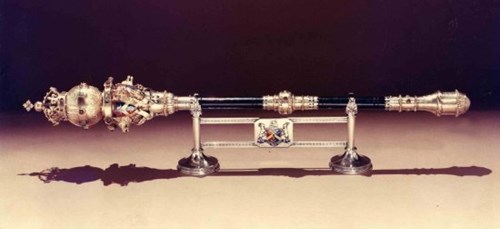
The Civic regalia and its history
'Civic regalia' is the name for the chains of office worn by the Lord Mayor, Lady Mayoress, the Deputy Lord Mayor and Deputy Lady Mayoress. The evening jewels, mace (symbolic decorated club) and city sword are part of the collection.
The Lord Mayor’s chain of office
Mayor Samuel Smith gave a massive gold chain to Bradford in 1854. The chain was to be worn on municipal occasions to dignify the Mayor. The chain was in a ribbon pattern, tied by a medallion. The badge was suspended from it and together they weighed 29.5 ounces and cost £250.

The Mayor's chain of 1854
In 1937 two animals that form part of Bradford's coat of arms – a ram and an Angora goat – were modelled in solid gold and added to the massive and exquisitely ornamented badge. The chain of office was then revalued at £562.
The two images below show the badge before and after this 1937 embellishment.

The Mayor's chain showing detail of the original medallion

Detail of the post-1937 medallion with the ram and goat now flanking the shield
The theft of the Lord Mayor’s chain
On Tuesday, 4 December 1945, the then Lord Mayor of Bradford – and the first female Lord Mayor – Alderman Kathleen Chambers JP, visited Leeds to attend a reception at the University. On her way she called at the offices of the Northern Committees’ Association for the Blind, of which she was chairman, in Blenheim Terrace. The Austin 24 civic car parked in the driveway and was soon hemmed in by other vehicles. The Lord Mayor’s chain of office was concealed in a secret compartment in a briefcase and could not be seen from the outside.
While the car was temporarily left unattended it was stolen and the vehicle was not recovered until just before midnight. The briefcase was empty. The combined police forces of Bradford and Leeds searched for the chain, while the press speculated that it was ‘a planned affair’.
The chain’s insurers offered a £100 reward for information, but it was never found. In 1945 prices the chain was estimated to be worth £1,000. Three Leeds men were later accused of involvement in the theft and in 1946 a man was jailed after the court was told that the chain had since been broken up.
Bradfordians rally to create a replacement
Gold was in short supply just after the war so Alderman William Illingworth, who had been Lord Mayor in 1940, launched an appeal to Bradfordians in the Telegraph and Argus. Local people responded well and contributed many items of old gold – from pencil holders and coins to military badges – towards the required 100 ounces.
The new chain was fashioned from the old gold in the Birmingham workshops of Fattorini and Sons Limited, under the watchful eye of William Norman, their chief designer. The new chain arrived in Bradford in March 1947 in time for formal presentation at the centenary meeting of the Council in June that year. On the reverse is an inscription which explains how it came to be made.

The Lord Mayor's replacement chain of 1947 - shown with the Lady Mayoress's chain inset - from a photographic survey of the Civic regalia in the 1960s by C H Wood
In 1974 Bradford became a metropolitan authority and acquired a new coat of arms, so the badge was replaced. In 1977 Mr and Mrs Colin Wilkinson and family generously donated a new solid gold badge, pictured below, bearing the new arms enamelled in full heraldic colours.

Lord Mayor's chain, with its 1977 medallion
The Lady Mayoress’s chain of office
The Council decided to buy a chain for the Mayoress and presented it to her on 14 February 1899. (We did not use the term ‘Lady Mayoress at that time.) The public could donate just over £1 each towards the cost.
Decorative gold lozenges around the chain bear the names of previous (lady) mayoresses. The badge has since been replaced by one bearing the post-1974 coat of arms.

The Lady Mayoress's chain, dates from 1899
The evening jewels
The day chains are very heavy for wearing at evening functions so the Lord Mayor and Lady Mayoress can wear lighter evening jewels on these occasions.
The Lord Mayor’s evening jewel was presented anonymously in 1954 and is of solid 18ct gold with the arms, crest and motto enamelled in brilliant colours. The goat is 18ct white gold and the ram is 18ct oxidized white gold. The diamond rose spray and all settings are in platinum.
The Lady Mayoress’s evening jewel was presented anonymously in 1955 and is described as a diamond collar necklet. There are 289 diamonds in the necklet making up four diamond festoons on each side, set in platinum. The pendant is crystal and platinum with a double circle of diamonds. It has the Bradford arms in relief enamel on the front and an inscription on the back.

Evening jewels - Lady Mayoress's on left, Lord Mayor's on right

Lord Mayor's evening jewel
The mace
The mace symbolises the authority of the Lord Mayor and is still regularly used in ceremonies today, carried by a macebearer.
Mayor Alderman Matthew William Thompson presented the mace in 1873 at the opening of the Town Hall. Thompson was a well-respected local figure and served as Mayor of Bradford for three terms in the Victorian period. The mace was made by the London firm Cox and Sons at a cost of £150. It is 9ct gold and is richly ornamented with boars’ heads and studded with semi-precious stones.
It is placed before the Lord Mayor at Council meetings. According to civic protocol the mace should be placed upside down in the presence of the monarch because their authority is greater than the Council’s.

Civic Mace, 1873, in a study by C H Wood

Deputy Lord Mayor's chain and original medallion in a study by C H Wood